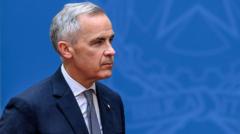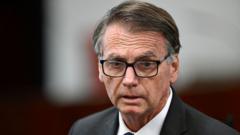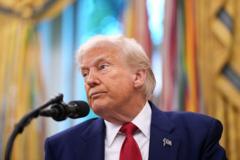As polls closed across Canada on April 28, 2025, the election results hinted at a dramatic shift in the political landscape. The Liberal Party, now led by Mark Carney, has gained traction against the Conservative Party, led by Pierre Poilievre, amid mounting concerns regarding U.S. relations and domestic policies.
Canada Faces Pivotal Election: Polls Close Amid Rising Tensions with Trump

Canada Faces Pivotal Election: Polls Close Amid Rising Tensions with Trump
Mark Carney's Liberal Party shows unexpected surge as Canadians vote to shape their future against President Trump's backdrop.
April 28, 2025, 8:45 p.m. ET – As the polls closed across Canada, a consequential election unfolded amid significant political tensions exacerbated by President Trump’s trade threats. Originally seen as favoring the Conservative Party, recent shifts suggested a potential upset as the Liberal Party under Mark Carney, who took over from former Prime Minister Justin Trudeau, appeared to gain a competitive edge.
Election night saw voters facing a critical choice, with Carney touting his financial expertise amidst global challenges, while Poilievre’s conservative platform attracted traditional right-wing supporters. Both leaders engaged in a head-to-head race for seats in Parliament, as Canadians looked for stability and guidance in turbulent times.
Early projections indicated that the Liberals had surged ahead, having taken a slight lead in the polls, reversing a more than 25-point deficit held by the Conservatives just months prior. Carney’s candidacy was bolstered by public discontent with Trump’s policies and a palpable change in sentiment regarding Canada’s reliance on U.S. economic support.
Beneath this political showdown was a backdrop of voter anxiety, especially regarding trade relations and economic stability, which overshadowed other pressing topics like immigration and climate change. Previous platforms and policies that tackled these issues had significantly lost public interest as Canadians headed to the polls.
In a parliamentary system where winning the most seats is vital for leadership, this election featured an array of smaller parties vying for representation, including the progressive New Democrats and the Bloc Québécois. The unfolding results will shape Canada's response to Trump’s aggressive tactics and redefine various political strategies moving forward.
As the night unfolds, Canadians remain keenly aware that their electoral choices will determine the country’s direction and the ability of their next leader to represent their interests on a global stage fraught with tension.
Election night saw voters facing a critical choice, with Carney touting his financial expertise amidst global challenges, while Poilievre’s conservative platform attracted traditional right-wing supporters. Both leaders engaged in a head-to-head race for seats in Parliament, as Canadians looked for stability and guidance in turbulent times.
Early projections indicated that the Liberals had surged ahead, having taken a slight lead in the polls, reversing a more than 25-point deficit held by the Conservatives just months prior. Carney’s candidacy was bolstered by public discontent with Trump’s policies and a palpable change in sentiment regarding Canada’s reliance on U.S. economic support.
Beneath this political showdown was a backdrop of voter anxiety, especially regarding trade relations and economic stability, which overshadowed other pressing topics like immigration and climate change. Previous platforms and policies that tackled these issues had significantly lost public interest as Canadians headed to the polls.
In a parliamentary system where winning the most seats is vital for leadership, this election featured an array of smaller parties vying for representation, including the progressive New Democrats and the Bloc Québécois. The unfolding results will shape Canada's response to Trump’s aggressive tactics and redefine various political strategies moving forward.
As the night unfolds, Canadians remain keenly aware that their electoral choices will determine the country’s direction and the ability of their next leader to represent their interests on a global stage fraught with tension.






















